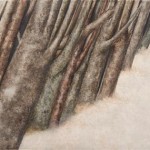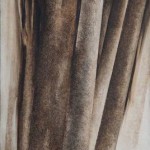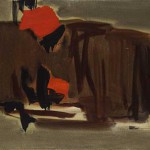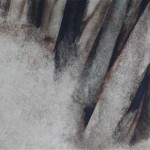
About Art Work
Major distinguishing features of Sohrab Sepehri’s art are exemplified in the present painting. Here, a selected piece of landscape, typically a dense setting of tree trunks, is depicted in the stylized, geometrical expression representative of Sohrab’s work. His palette in this painting is characteristically limited and low-keyed, the minimized few elements playing the main role in the composition. The method of pigment application creates a Rough and spongy texture on the tree trunks, while the light-coloured background intensifies the dominance of the main compositional elements. The artist’s meticulous choice of frame, arrangements, colour juxtapositions and minimum visual components find its counterpart in his succinct poetry. His approach to painting is careful and cautious, imbued with a poetical sensibility.
Sohrab Sepehri belongs to a generation of Iranian Modern artists known as the ‘poet painters’. Rising from the context of Iranian modern thought and literature, this movement was set by poets and writers who started painting alongside literary creation. Among these literates, Sohrab is a prominent artistic figure who demonstrates parallel, consistent traits in his painting and poetry. He frequently acknowledges his painterly practice in his poetry: “I build up a cage by paint, sell it to you to refresh your heart through the song of the anemone imprisoned in it.” The visual rendition of this meaning is recurrent in Sohrab’s painting: “the tall cypress trees”, t“he glaze of the shimmering moon”, “the song of the anemone”, “the unattainable flowers”, “the pond of the moment” and “the epic trees” find their visual realization in Sohrab’s paintings.
Sepehri’s unique perception of nature and its representation comes from his extensive traveling. He began his career as a student in the Faculty of Fine Arts, University of Tehran. Here he was among the second generation of Iranian modern artists. His trips to Europe, especially Paris, were vital in building a new awareness of European Modernism. In the beginning of 1960s, however, an initial desire to learn the art of woodcut and engraving lead him to Japan, where he became deeply absorbed by the local arts and culture. The fascination with an Eastern insight which resulted from this experience led the artist to develope a minimalistic, meditative approach to nature. This was how Zen beliefs and far-eastern philosophy found their way to Sohrab’s imagination. The main characteristics defined in “Seven Principles of Zen” are also evident in Sohrab’s art: asymmetry, purity, stability, impulsiveness, profundity, satiety, silence and tranquility.
Sohrab also demonstrates notable attachment to his homeland, Kashan. Many of the landscapes represented in his paintings are actually chosen from its fields and deserts. This Iranian scenery seen through the artist’s oriental worldview demonstrates his awareness of Oriental mysticism as well as Western Modern artistic practice. Sohrab acknowledges the oriental canons, including the seventeen syllables in a Haiku poem, and extends these canons to his landscape painting, making it as minimal and refined as possible, while conveying a vast and profound impression. Alongside this oriental insight, the compositional principles like balance, attentive application of pigment and geometrical awareness reveal his knowledge about formal principles and conventions of Western modern art.
An account of Four Elements might be found in Sohrab’s paintings, the elements being earth, water, tree and sky. Water symbolizes fluidity, light, and purity, while the tree stands for fertility and the passage of time, and the sky is presented as the flowing soul overseeing the whole universe. The trees are often depicted in a tilted, upward movement, symbolizing mediation between the heavenly and the earthly worlds.
Many Iranian modern painters have chosen the nature -particularly the trees- as their main subject matter. Sohrab’s focus, however, falls on the tree trunks, which defies a common, realistic imagery if a tree. It lacks the shadow, the branches and the leaves. Sepehri’s trees, nonetheless, express the nature’s solidity and strength, a vision intensified by the use of a limited palette of grays, browns, ochre and jade green.
The trees also represent careful and measured framing of nature. Their shapes oscillate between flatness and volume, sometimes they represent a colourful surface relating to the neighboring tones, sometimes they resemble a sculptural fragment cut and attached to the canvas surface. Frequently repeated in vivid tones and commanding profile, the trees are vital elements of the most prolific phase in Sohrab Sepehri’s artistic career. They create a rhythmic pulse which unifies their plenty in a consistent plastic expression. Sohrab’s trees seem to song the sweet song of life; their arrangements speak of an invisible forest, whose presence is endlessly repeated in the painting as well as in our souls. Sepehri’s illustration of nature is pure and refined, with no trace of the presence of humans; because in his worldview, the mankind is metamorphosed into trees, flowers, colour patches and deserts.





